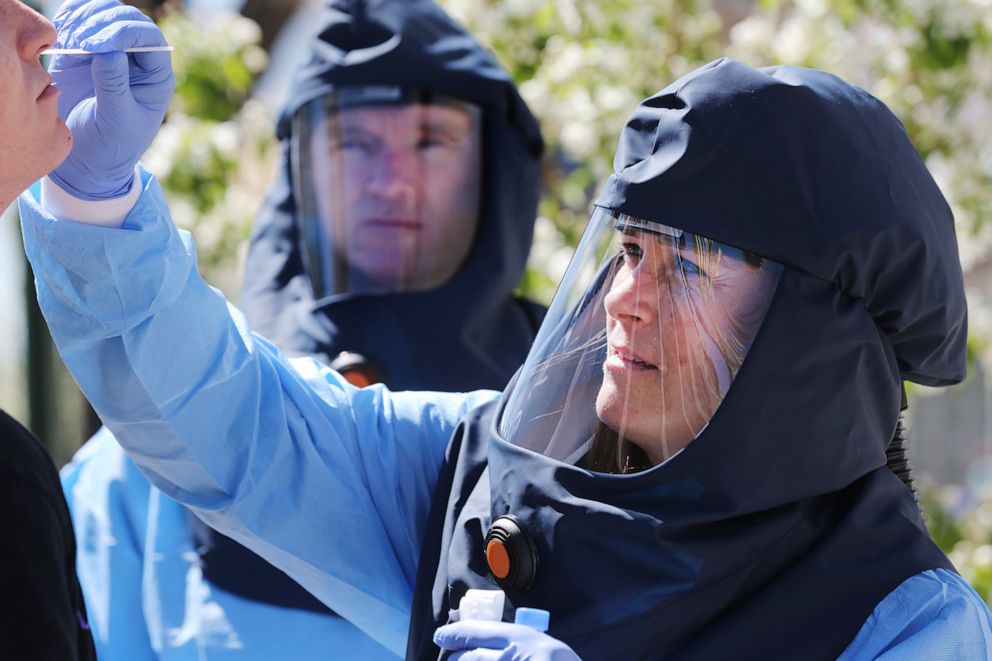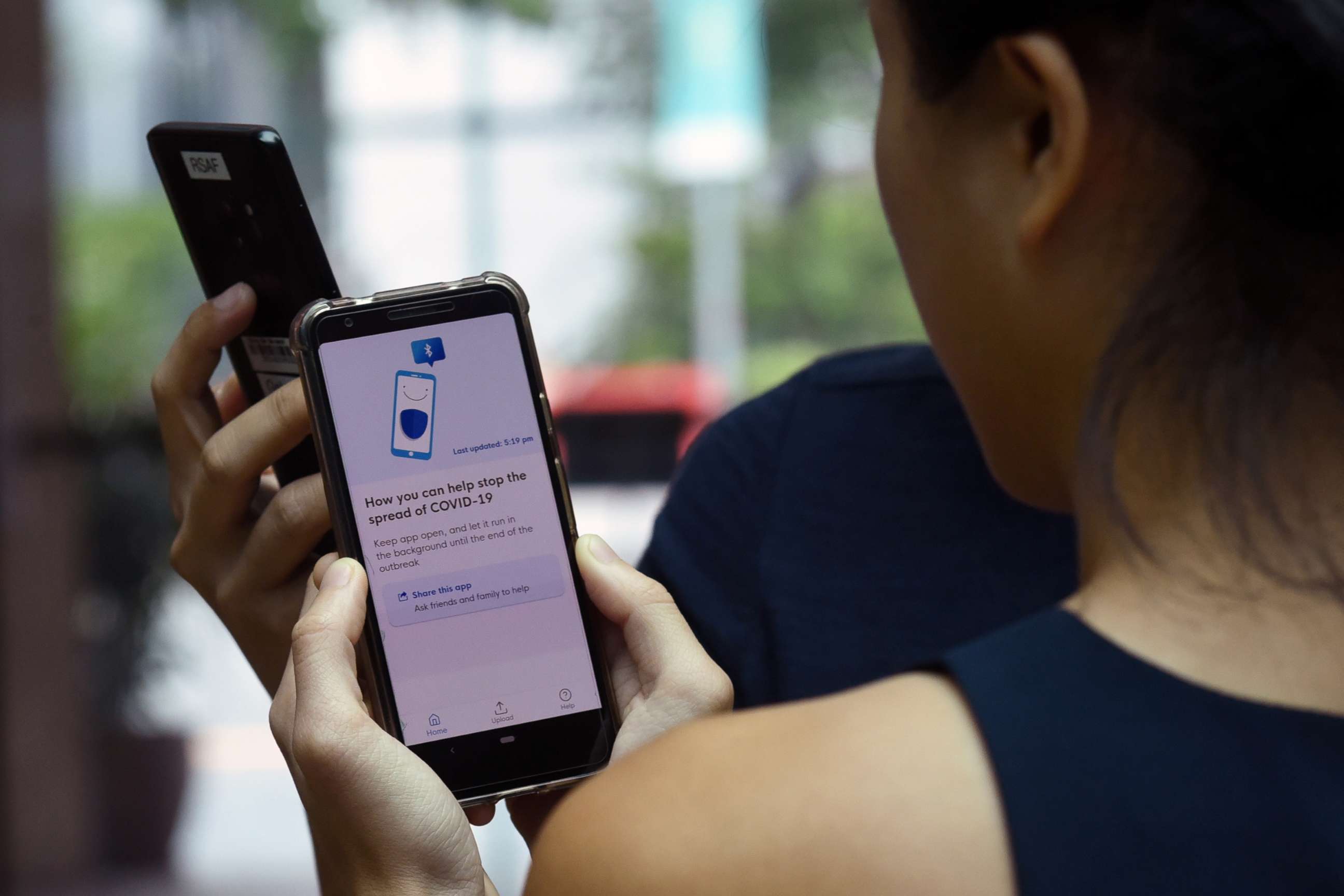States race to start coronavirus contact tracing, a monumental task ahead
Experts estimate 100,000 more people across the country are needed to help.
Contract tracing, the ability to track down everyone with whom a coronavirus-positive person has significantly interacted, is seen by experts as one of the keys to halting the spread of the deadly disease. But as multiple states now race to put together their own contract tracing teams, state health departments told ABC News the task is monumental and some said they need more help from the federal government.
A massive effort is currently underway by states across the country to recruit more manpower for the complex effort, which experts say will require billions of dollars and tens of thousands of people in an unprecedented effort to contain the virus by going from person to person.
“It’s like an emotional roller coaster in a way,” Mia Williams, an epidemiologist who does contact tracing in Kentucky, said of the process. “Because what you’re trying to do is connect all of these cases and from connecting all of those cases you’re trying to prevent or control spread.”
A report co-authored by university health experts and a group representing state and territorial health officials estimates that in order to “trace all contacts, safely isolate the sick, and quarantine those exposed,” the country needs to add 100,000 contact tracers to the current effort, to the tune of $3.6 billion dollars. Former Centers for Disease Control and Prevention director and New York City health commissioner Tom Friedman said he believes the country needs “an army of 300,000 people.”
Vice President Pence said this week that the CDC would be deploying teams of 10 to 12 people to each state to assist the local efforts on 12-to 18-month rotations, and recently CDC Director Robert Redfield suggested his agency would work with states to deploy many more people. But some lawmakers say the federal government will need to do much more for contact tracing in order to help states safely re-open the country.
Among states, plans and personnel vary to confront tracing challenges
Gov. Gavin Newsom of California announced Wednesday afternoon that the state is building a massive army of 10,000 tracers as part of its efforts to prepare the state for future reentry. Newsom added that tracing is "not just about numbers," but also "about quality," explaining that the state is implementing systems to ensure good information is collected.
Massachusetts is in its second week of a contact tracing program that’s among the most aggressive in the nation. The state has hired more than 300 people to begin tracing and in the first week of the program contact investigators reached 765 Massachusetts residents who have tested positive.
Those 765 people have identified more than 1,000 close contacts, meaning someone they spent more than 15 minutes within six feet of during the three days before their positive test, an illustration of the race the contract tracers are in against the potential spread of the virus. Contact tracers have reached 626 of those second-order contacts.
Massachusetts also says they have nearly 2,000 volunteers prepared to assist their contact tracing investigation. The state has partnered with various public and private institutions across the state through the launch of the “Community Tracing Collaborative,” according to Omar Cabrera, a spokesperson for the health department. Cabrera said the program has already received 13,000 applications for both paid and unpaid positions and is looking to hire up to 1,000 additional people.
Dr. Joia Mukherjee, the chief medical officer for the Boston-based Partners in Health, the nonprofit working with Massachusetts on the state’s coronavirus contact tracing program, said investing the stimulus money into “hiring millions of people to do contact tracing, putting hoteliers and hotel workers back to worth providing housing and isolation, putting restaurateurs and line cooks back to work by providing food to people who need to stay in quarantine,” could potentially shorten the epidemic.
“This is really doable, the contact tracing piece,” Mukherjee said. “But it has to be heavily invested in.”
Maryland and Minnesota already have contact tracing teams in place, but health officials from both states said they would need hundreds more people to be effective. Maryland estimates it will need to quadruple staffing from 250 contact tracers to close to 1,000. Minnesota health officials said they’ll need to increase their contact tracing staff which is currently about 100 people, seven fold. North Carolina’s health department spokesperson also said the state will need “a much larger team” going forward.
“Where the personnel would come from, that’s part of the planning effort,” said Doug Schultz, a spokesman for the Minnesota Health Department.
In New York City, Mayor Bill de Blasio said “thousands and thousands” of contact tracers would be put to work identifying potential coronavirus carriers who will be isolated in hotels bought out by the city. New York state, which alone has experienced a higher number of cases than any single country outside the U.S., announced Wednesday 35,000 State University of New York and City University of New York students will spearhead an army of tracers in the medical field in an effort being led by former Mayor Michael Bloomberg.
“It’s a very big undertaking, and we thank him very much for taking it on because it is going to require a lot of attention, a lot of insight, a lot of experience and a lot of resources,” New York Governor Andrew Cuomo said Wednesday.
As efforts expand, states including Colorado, Kentucky, New Jersey, Alabama, Utah, Oklahoma and North Carolina are calling on either medical students or school nurses in their contact tracing efforts or, like New York, are looking to students and the unemployed for help.
“There are a lot of people in the U.S. right now who are out of work we could probably hire those people into public health departments and that's how we would build out the workforce we need,” Dr. Marcus Plescia, chief medical officer at the Association of State and Territorial Health Officials, told ABC News.

In Salt Lake County, Utah, the state says contact tracers have tracked 85% of the known cases.
Salt Lake County nurse Lee Cherie Booth, who has been working as a tracer since early March and has been spending upwards of ten hours a day for six or seven days a week identifying and alerting the contacts of infected individuals.
Booth explained that the tracing process is more than just a simple phone call, saying that the tracers go through "day by day" with the infected Utahans, mapping out their schedule, "establishing that perimeter" and "footprint of wherever they went."
She said the process is "like a web that can potentially go and go and go if people don’t stay put... . Hopefully there’s enough education out there that people can be smart."
“It’s like this web that can potentially go and go and go if people don’t stay put” at home, Booth said, adding that tracers’ work could be made more difficult when Utah fully reopen. She said she could potentially see the state having another spike and said “hopefully there’s enough education out there that people can be smart.”
Amelia Prebish, who leads the Utah Department of Health’s contact tracing effort, said she was aware of the government’s effort to send additional support teams from the CDC, but it “sounds like there are more logistics to work out at the national level.”
In Vermont, on the other hand, officials said it has received all the resources it needs from the federal government. The state says it has become less cumbersome because residents are following social distancing guidelines, but the initiative will be just as crucial as the state begins to soften restriction. Vermont’s team has expanded from a small team of six to eight people to over 30 dedicated personnel over the course of the pandemic. CDC and the Federal Emergency Management Agency have both sent teams to assist.
In Rhode Island, 100 members of the National Guard are assisting the effort alongside 140 staffers from the health department. The state is also partnering with the global software company SalesForce which is creating a database to allow for the Guard and their department of health “to do contact tracing more efficiently and effectively.”
The health department for Georgia, which is among the states most aggressively moving toward re-opening the local economy, did not provide ABC News with any information about a contact tracing plan, despite federal guidelines calling for "the ability to quickly set up safe and efficient screening and testing sites for symptomatic individuals and trace contacts of COVID+ results." Georgia Gov. Brian Kemp said some businesses would be reopening as soon as Friday.
According to a local report from The Macon Telegraph, at least 13 counties in the state were not able to conduct contact tracing due to lack of staffing.

To augment the tracing efforts, some of the states, including Colorado, Connecticut and Nevada, are also looking into tech-based solutions in coordination with local partners and tech companies in an effort to lighten some of the workload, like assisting in identifying and tracking symptoms, sending isolation and quarantine recommendations, and asking a series of questions by phone call, text exchange and survey.
But even with technological help, the main challenge remains the colossal size of the task and the basic need for more people, Nevada health department spokesperson Shannon Litz said.
Feds look to boost local efforts, Dem lawmakers want more action
CDC Director Robert Redfield told state governors this week that contact tracing “is really an important component of the guidelines to open America again,” according to an audio recording of the call obtained by ABC News. Redfield said his department was working with local health departments to drastically increase the personnel on the ground dedicated to the effort.
“Literally thousands of more individuals starting to get placed in the states working with your state public health leadership to determine the right mix,” he said, emphasizing the importance of a strong posture towards containing the virus especially into next winter.
Some U.S. senators have looked to states with successful initiatives to urge the federal government to use the ramp of contact tracing as an opportunity to potentially employ hundreds of thousands of Americans whose jobs have been impacted by coronavirus.
Sen. Chris Van Hollen, D-Md., and Sen. Ed Markey, D-Mass., have introduced legislation that would expand authorization of volunteer opportunities within AmeriCorps and the Federal Emergency Management Agency geared towards prioritizing the response to the pandemic on the front lines. Van Hollen and Markey say this legislation would “ensure that the most vulnerable in our society are not left behind.”
“It is not too late for President Trump to embrace America’s strong history of national service by mobilizing our people as a cornerstone of the whole-of-government response to the coronavirus pandemic,” Markey said in a statement last week. “Americans stand ready and waiting to help in this pandemic response.
Sen. Coons, D-Del., also announced on Wednesday the Pandemic Response and Opportunity Through National Service Act, which would fund 750,000 national service positions over a three-year response and recovery period, in part to meet the projected need for as many as 300,000 public health workers. The group of Democratic senators who have signed onto the bill are actively working to include it in the next COVID-19 relief package.
“[A]s our country faces the dual challenge of responding to a global pandemic, a national public health crisis, and a very sharp economic crisis, I think this is exactly the time for us to call on Americans to respond and to serve,” Coons said.
ABC News' Benjamin Siegel and Aaron Katersky contributed to this report.




